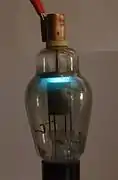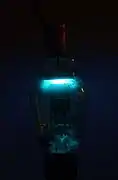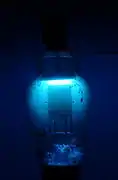| 866A | |
|---|---|
 Westinghouse 866A mercury vapor half-wave rectifier tube. | |
| Classification | Diode |
| Cathode | |
| Cathode type | Directly heated |
| Heater voltage | 2.5 |
| Heater current | 5 A |
| Anode | |
| Max voltage | 5000 |
| Max current | 250 mA |
| References | |
| RCA Transmitting Tube Manual TT-3, 1940 | |
The 866 is a mercury vapor half-wave rectifier intended for high-voltage applications. The voltage drop is approximately 15 volts up to 150 Hz. To avoid unwanted shorts the tube must be operated in a vertical position and the filament preheated for at least 30 seconds before applying the plate voltage.[1]
Construction
Structurally, it consists of a linear electrode arrangement; a cup shaped anode with top cap and a cylindrical cathode. The socket is a medium 4 pin bayonet UX-4 and the glass envelope is ST-19. The 2.5 volt/ 5 Amp filament is connected to pins 1 and 4.
Operation
Under normal operating conditions the tube glows blue and mercury droplets are visible.
Pictures in working conditions
 Westinghouse 866A mercury vapor half-wave rectifier tube. Glowing with 5mA
Westinghouse 866A mercury vapor half-wave rectifier tube. Glowing with 5mA Westinghouse 866A mercury vapor half-wave rectifier tube. Glowing with 5mA in the dark (long exposure)
Westinghouse 866A mercury vapor half-wave rectifier tube. Glowing with 5mA in the dark (long exposure) Westinghouse 866A mercury vapor half-wave rectifier tube. Glowing with 180mA in the dark.
Westinghouse 866A mercury vapor half-wave rectifier tube. Glowing with 180mA in the dark.
References
Further reading
- RCA Transmitting Tube Manual TT-3. Radio Corporation of America. 1940. pp. 64–65.
External links
This article is issued from Wikipedia. The text is licensed under Creative Commons - Attribution - Sharealike. Additional terms may apply for the media files.